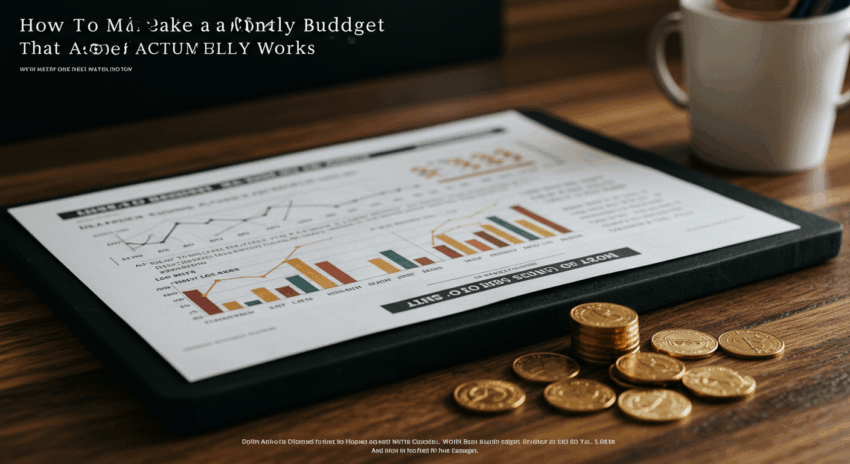Are you tired of creating a monthly budget only to see it fall apart by the second week? You’re not alone. Many people struggle to craft a financial plan that truly sticks. The good news is that creating a monthly budget that actually works is not an unattainable dream. This article will guide you through the practical steps and proven strategies to take control of your finances, understand your spending habits, and ultimately achieve your financial aspirations. We’ll explore how to build a realistic and flexible budget tailored to your life, ensuring you can manage your money effectively and confidently.

Why Most Budgets Fail
Before diving into how to create a successful budget, it’s crucial to understand why many attempts fail. Often, budgets are too restrictive, failing to account for life’s unpredictabilities or individual spending personalities. Some people set unrealistic expectations, leading to discouragement when they can’t meet them. Others simply don’t track their spending accurately, making their budget an exercise in guesswork rather than a reflection of reality. A lack of clear financial goals can also undermine motivation, making it hard to see the purpose behind the discipline. Recognizing these common pitfalls is the first step towards building a system that avoids them.
The Foundation: Understanding Your Income and Expenses
The cornerstone of any effective monthly budget is a clear understanding of what money comes in and where it goes out. Without this foundational knowledge, you’re essentially navigating your personal finance life in the dark.
Tracking Your Income is the first step. Identify all sources of income you receive each month. This includes:
- Fixed Income: This is predictable income like your monthly salary after taxes, regular pension payments, or any other consistent earnings.
- Variable Income: This can fluctuate. Examples include freelance work, commissions, bonuses, or income from a side hustle. If your income is highly variable, calculate an average from the past few months, or use a conservative estimate.
Next, and equally important, is Tracking Your Expenses. This is often the most eye-opening part of the budgeting process. Diligently record every penny you spend for at least one month. Categorize your expenses to see where your money is truly going:
- Fixed Expenses: These are generally the same amount each month and are non-negotiable in the short term. Examples include rent or mortgage payments, loan repayments (student loans, car loans), insurance premiums, and regular subscription services.
- Variable Expenses: These costs change from month to month based on your usage and choices. Common examples are groceries, dining out, transportation (fuel, public transport), utilities (electricity, water, gas – though some can be fairly stable), entertainment, and personal care.
- Occasional or Irregular Expenses: These don’t occur monthly but can significantly impact your budget if unplanned. Think of annual subscriptions, holiday gifts, car maintenance, medical co-pays, or home repairs. It’s wise to set aside a small amount each month for these.
To track effectively, choose a method that suits you. Some prefer digital tools like budgeting apps or spreadsheets (Excel, Google Sheets), which can automate calculations and categorizations. Others find success with a traditional notebook and pen. The key is consistency in your tracking expenses efforts.
Choosing the Right Budgeting Method
Once you have a handle on your income and expenses, it’s time to choose a budgeting method. There’s no one-size-fits-all approach; the best method is the one you can stick with. Here are a few popular and effective strategies:
The 50/30/20 Rule is a simple guideline for allocating your after-tax income:
- 50% for Needs: These are your essential expenses – housing, transportation, groceries, utilities, insurance, and minimum debt payments.
- 30% for Wants: This category covers discretionary spending – dining out, entertainment, hobbies, shopping for non-essentials, and vacations.
- 20% for Savings and Debt Repayment: This portion is dedicated to building your financial future. It includes contributions to an emergency fund, retirement accounts, investments, and paying down debt beyond the minimum payments. This is key for saving money.
Zero-Based Budgeting is a more meticulous method where every dollar of your income is assigned a specific purpose. The formula is simple: Income – Expenses = Zero. This doesn’t mean you spend everything; ‘expenses’ in this context include allocations to savings, investments, and debt repayment. This method ensures you are consciously deciding where all your money goes.
The Envelope System is a classic cash-based approach, particularly useful for controlling variable spending categories where you tend to overspend. You allocate a specific amount of cash into physical (or digital) envelopes for categories like groceries, entertainment, or clothing. Once an envelope is empty, you stop spending in that category until the next budget period.
The Pay-Yourself-First Method prioritizes savings. Before you pay any bills or spend on anything else, you allocate a predetermined amount or percentage of your income directly to your savings accounts or investments. The rest of your income is then used for your expenses. This ensures your savings goals are met consistently. You might combine this with other methods.
Setting Realistic Financial Goals
A budget without goals is like a ship without a rudder. Your financial goals provide direction and motivation, transforming budgeting from a chore into a tool for achieving what’s important to you. Goals should be categorized by timeframe:
- Short-Term Goals (within 1 year): These often focus on building financial stability. Examples include creating an emergency fund (typically 3-6 months of living expenses), paying off small, high-interest debts (like credit card balances), or saving for a specific purchase like a new appliance.
- Medium-Term Goals (1-5 years): These usually involve larger sums of money and more planning. Think of saving for a down payment on a house or car, funding a significant vacation, or saving for educational expenses.
- Long-Term Goals (5+ years): These are crucial for your future security and often involve substantial amounts. The most common long-term goal is retirement planning, but it could also include saving for children’s education or making significant investments.
To make your goals effective, ensure they are SMART:
- Specific: Clearly define what you want to achieve (e.g., “Save $5,000 for an emergency fund” instead of “Save more money”).
- Measurable: Establish criteria for tracking progress (e.g., “Save $417 per month for 12 months”).
- Achievable: Set goals that are realistic given your income and financial situation. Overly ambitious goals can lead to frustration.
- Relevant: Ensure your goals align with your values and overall life plan.
- Time-bound: Set a deadline for achieving your goal. This creates a sense of urgency and helps in planning.
Write down your financial goals and revisit them regularly. This keeps them top-of-mind and allows you to adjust your budget as needed to stay on track.
Building Your Budget Step-by-Step
Now, let’s put it all together. Here’s a practical, step-by-step guide to constructing your monthly budget:
- Calculate Your Total Monthly Income: Sum up all your reliable income sources after taxes. If your income is variable, use a conservative average or your lowest anticipated amount for that month. This provides the baseline for your budget.
- List All Your Fixed Expenses: Itemize expenses that remain constant each month, such as rent/mortgage, loan payments, insurance premiums, and fixed subscription costs. Total these up.
- Allocate for Variable Expenses: This is where your previous tracking expenses comes in handy. Based on your past spending and your financial goals, assign amounts to categories like groceries, transportation, utilities, entertainment, and personal care. Be realistic but also look for areas where you can potentially cut back to free up funds for savings or debt repayment.
- Prioritize Savings and Debt Repayment: This is crucial. Following the ‘pay yourself first’ principle, allocate a specific amount towards your emergency fund, retirement accounts, investments, and any debt management goals (especially high-interest debt). Treat these as non-negotiable expenses for effective saving money.
- Do the Math: Balance Your Budget: Subtract your total estimated expenses (fixed + variable + savings/debt repayment) from your total monthly income.
- If you’re using zero-based budgeting, your income minus expenses should equal zero. Every dollar has a job.
- If you have money left over, great! Allocate it towards your financial goals – perhaps boost your savings or make an extra debt payment.
- If your expenses exceed your income, you have a deficit. You’ll need to revisit your variable expenses (and sometimes even fixed ones, if possible, in the longer term) to find areas to reduce spending or explore ways to increase your income.
- Create a Budget Document: Whether it’s a spreadsheet, a budgeting app, or a dedicated notebook, formalize your budget. Seeing it written down makes it more concrete.
Remember, your first budget is a starting point. It will likely require adjustments as you live with it and learn more about your actual spending patterns. Explore different options and tools on our Home page for more insights into personal finance.
Implementing and Sticking to Your Budget
Creating a budget is one thing; making it a sustainable habit is another. Consistent implementation and a willingness to adapt are key to long-term success with your monthly budget.
Regular Review and Adjustment is paramount. Your budget isn’t a “set it and forget it” document. Plan to review your spending against your budget at least once a week, or bi-weekly. This allows you to catch overspending early, understand why it happened, and make necessary adjustments for the rest of the month or for the next budget period. Are your estimates for groceries too low? Are you spending more on entertainment than planned? Regular check-ins provide these answers.
Handling Unexpected Expenses is a reality of life. A car repair, a medical bill, or an urgent home maintenance issue can derail even the best-laid budget if you’re unprepared. This is where an emergency fund is invaluable. Aim to build an emergency fund covering 3-6 months of essential living expenses. When an unexpected cost arises, you can draw from this fund instead of going into debt or sacrificing other critical budget categories.
Staying Motivated can be challenging, especially when you’re making sacrifices. Combat this by:
- Visualizing your financial goals: Keep reminders of why you’re budgeting (e.g., a picture of your dream vacation spot, a chart showing your debt reduction progress).
- Celebrating small wins: Acknowledged when you meet a mini-goal, like sticking to your grocery budget for a month or making an extra debt payment. This doesn’t have to involve spending money; it can be a moment of self-acknowledgment.
- Finding an accountability partner: If it helps, share your goals with a trusted friend or family member.
Finally, embrace Flexibility. Life changes, and so will your financial needs and priorities. A budget should be a flexible guide, not a rigid straitjacket. If you overspend in one category, try to underspend in another to compensate. If you get a raise or your expenses change significantly, update your budget accordingly. The goal is progress, not perfection, in your journey of saving money.
Leveraging Technology and Tools
In today’s digital age, numerous tools can simplify the budgeting process and help you stay on track. Leveraging technology can make managing your personal finance more efficient and less daunting.
Budgeting Apps are incredibly popular for good reason. Many apps connect directly to your bank accounts and credit cards, automatically categorizing transactions and providing real-time updates on your spending. Features often include:
- Automated tracking expenses and categorization.
- Budget creation and progress monitoring.
- Bill reminders and alerts for unusual spending.
- Goal setting and tracking for your financial goals.
- Financial insights and reports.
Explore different apps to find one whose interface and features best suit your needs. Some offer free versions with basic functionalities, while others have premium features for a subscription fee.
Spreadsheets (like Microsoft Excel or Google Sheets) remain a powerful and customizable option. If you prefer more control or have unique budgeting needs, spreadsheets allow you to design your monthly budget from scratch. You can create custom categories, formulas, and reports. Many free templates are also available online that you can adapt.
Many Online Banking Platforms now offer built-in budgeting tools. These can include features like expense categorization, spending trackers, and savings goal tools directly within your banking interface. Check what your bank offers, as this can be a convenient way to get started without needing a separate app or system. These tools can offer valuable insights into your finance management.
The best tool is ultimately the one you will use consistently. Experiment with a few options to find what makes budgeting easiest and most effective for you.
Beyond Budgeting: Linking to Broader Financial Health
A well-managed monthly budget is more than just an accounting exercise; it’s a fundamental pillar of overall financial health and a gateway to achieving broader financial objectives. It provides the clarity and control needed to make informed decisions about your money.
Your budget directly supports your saving money goals. By identifying areas where you can reduce spending, you free up funds that can be allocated towards building an emergency fund, saving for a down payment, or investing for the future. Consistent budgeting makes saving a deliberate act rather than an afterthought.
Effective budgeting is also intrinsically linked to debt management. Understanding your income and expenses allows you to see how much you can realistically allocate towards paying down debt each month. You can strategize which debts to tackle first (e.g., high-interest credit cards) and accelerate your journey to becoming debt-free.
Furthermore, a solid budget lays the groundwork for future investments. Once you have control over your cash flow, have an emergency fund in place, and are managing debt effectively, you can confidently allocate funds towards investment opportunities that align with your risk tolerance and long-term financial goals. Budgeting ensures you are investing money you can afford to, rather than funds needed for essential living expenses.
Conclusion
Creating a monthly budget that actually works is an empowering step towards financial freedom and security. It’s not about restriction; it’s about making conscious choices with your money to build the life you desire. By understanding your income and expenses, choosing a suitable budgeting method, setting clear financial goals, and consistently reviewing and adjusting your plan, you can transform your relationship with money.
Remember, the perfect budget is the one that works for you – one that is realistic, flexible, and aligned with your personal aspirations. Embrace the process, be patient with yourself, and celebrate the progress you make. With commitment and the right strategies, you can master your personal finance and achieve your dreams.
Frequently Asked Questions (FAQ)
How often should I review my budget?
It’s generally recommended to review your monthly budget at least once a week or bi-weekly. This frequency allows you to track your spending against your plan, catch any overspending early, and make timely adjustments. A monthly review is also essential to assess overall progress and plan for the upcoming month. However, find a rhythm that works for you; the key is consistency.
What if my income is irregular?
Budgeting with irregular income can be challenging but is certainly achievable. One common approach is to budget based on your lowest anticipated monthly income. When you have a higher-income month, allocate the surplus towards savings, debt repayment, or an “income smoothing” fund to cover shortfalls in leaner months. Alternatively, you can calculate an average monthly income based on the past 6-12 months and use that as your baseline, but always have a plan for months where income falls below average. Prioritizing an emergency fund is even more critical with variable income.
Is it okay to go over budget in some categories sometimes?
Yes, it’s perfectly normal and often unavoidable to occasionally go over budget in certain categories. Life is unpredictable. The key is how you handle it. If you overspend in one area, try to compensate by underspending in another, less critical category for that month. If you consistently overspend in a particular category, it might mean your initial allocation was unrealistic, and you need to adjust your budget allocations for future months. A monthly budget is a guide, not an unbreakable rule; flexibility is important for managing your personal finance effectively.





